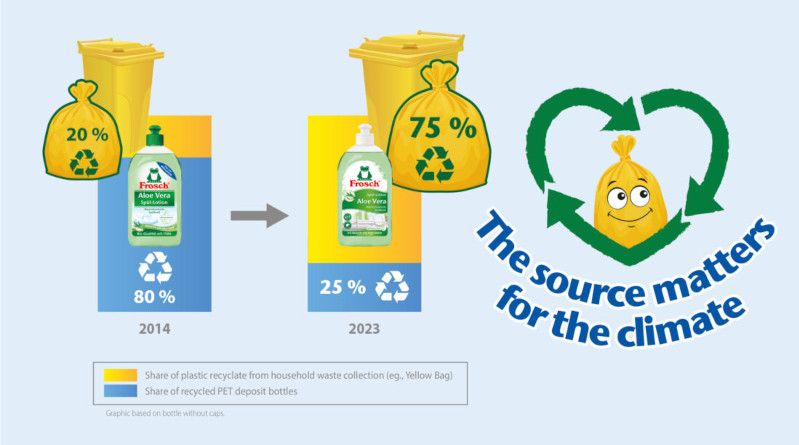Werner & Mertz in cooperation with Alpla has increased the share of rPET from the Yellow Bag to 75% in their bottles
With its thoroughly crafted collection of plastic packaging via the dual system, Germany developed one of the most effective ideas for the circular economy. This collection system is the perfect source for creating new packaging through resource-conserving mechanical recycling. The more plastic is kept in a closed loop, the less new plastic has to be produced. Consequently, less plastic waste is generated. That is true recycling in the interests of a climate-friendly circular economy.
Werner & Mertz and its partner Alpla in the Recyclate Initiative have again successfully cooperated in order to establish a genuine circular economy. For its Frosch PET bottles of 100% recycled plastic, the Germany-based cleaning products manufacturer was able to increase the share of rPET from the Yellow Bag to 75%. The remaining 25 % of material, which also is mechanically recycled, comes from European deposit bottle collection (Bottle to Bottle). The step up to 75% was made possible by a state-of-the-art sorting facility and knowledge acquired from continuous monitoring of the delivered PET bales in the recycling plant.
Alplarecycling was able to increase sorting efficiency with their software and computer technology which allow for more precise sorting at higher speed. Packaging experts from Werner & Mertz examine the bales of used plastic delivered to the recycling plant. At regular intervals on site, they analyze the materials and their quality in PET bales awaiting recycling. Knowledge of this particular waste stream goes into process development.
The source matters for the climate
Where the plastic packaging comes from is vitally important:
As proven in practice over and over again, used plastic from the Yellow Bag can be sorted by type and recycled cleanly in a high-quality upcycling process. Given its low melting point, plastic is well-suited for use again and again. Mechanical recycling of plastic is the most direct and energy-efficient form of the circular economy in our industry.
In a study conducted by ETH Zürich1 in 2022, analysts concluded: “twice as much fossil carbon is combusted as fuel for plastics production than contained as feedstock in plastics.” The alarming results are particularly noteworthy because research to date has concentrated on the environmental pollution that occurs with the disposal of plastic. Those damages alone are enormous. The incineration of plastic packaging, the primary means of disposal in Germany and other European countries, generates on average three grams of CO2 for every gram of plastic. Moreover, burning the plastic is a tremendous waste of a valuable raw material.
The fact that the manufacture of new plastic generates even more greenhouse gas emissions than incineration means the carbon footprint of virgin plastic is much worse than previously assumed. The major factor for the enormous amounts of energy used in production, according to researchers, is the continuously increasing use of coal-generated electricity. That applies primarily for the booming plastic economy in emerging markets in China, India and Indonesia, where the required energy for new plastic comes mainly from climate-damaging coal-powered plants.
Many EU countries and Western industrialized countries, the study reports, have outsourced energy-intense manufacturing of plastic to those countries.
In pyrolysis, the used plastic is decomposed into its petrochemical components at temperatures up to 1,500°C so that it can be processed into plastic again with help from new oil.
The many variations of pyrolysis—also known as “chemcycling” or “chemical recycling”—have one thing in common. They require a lot of energy, for example, to obtain plastic from pyrolysis oil. A study by a major environmental organization documents the poor track record of this process. To convert one metric ton of used plastic into plastic, pyrolysis needs one metric ton of fossil fuel as an additional energy supplier. Independent experts therefore see pyrolysis not as a variety of recycling, but rather as a variant of incinceration.
This source does not protect the climate. Every gram of incinerated plastic generates about three grams of CO2. On top of that, a large quantity of material is lost to pyrolysis. In most cases, the small amount of pyrolysis oil obtained can be processed further only after additional, time-consuming chemical cleaning.

